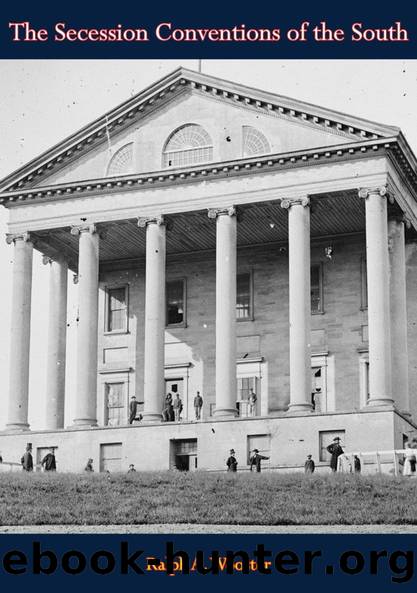The Secession Conventions of the South by Ralph A. Wooster

Author:Ralph A. Wooster [Wooster, Ralph A.]
Language: eng
Format: epub
ISBN: 9780837184364
Google: _HEqAAAAYAAJ
Publisher: Greenwood Press
Published: 1976-01-15T03:08:02+00:00
12 â NORTH CAROLINA
NORTH CAROLINAâS road to secession was unlike that of her sister to the south, South Carolina. The late James G. Randall noted that ânowhere was the contrast between upper and lower South better revealed than in the difference between the two Carolinas.â{375} South Carolina had been the first state to pass an ordinance of secession; North Carolina was the last. Like the other states of the upper South, North Carolina was torn between the two powerful forces of unionism and secession. And like her sister states of the upper South, North Carolina did not succumb to either force until the firing upon Fort Sumter and Lincolnâs call for troops made war inevitable. Only then, and without enthusiasm but with steadfast purpose and almost complete unanimity upon the part of her citizenry, did North Carolina leave the Union.
North Carolinaâs action in the sectional crisis was similar to that of Virginia. The compromise adopted by Congress in 1850 had been accepted by most North Carolinians as a settlement of the sectional differences, and during the early 1850âs hope prevailed that further difficulties might be averted.{376} Debates on the Kansas question, while of interest, failed to excite a majority of North Carolinians and the Dred Scott decision defending slavery in the territories seemed reassuring to even staunch southern-rights advocates. John Brownâs raid on Harpers Ferry disturbed North Carolinians but conservative leaders still hoped for peace on the eve of the election of 1860.{377}
Although the radical spirit was growing, North Carolinians maintained a conservative attitude throughout the troubled campaign of 1860. The North Carolina delegation to the Charleston Democratic convention consisted primarily of moderates who refused to join with delegates from the cotton states who withdrew from the convention hall. This stand received widespread approval throughout the state and it was believed that the subsequent meeting at Baltimore would result in the unification of the party. When this convention refused to seat the old delegates, however, most of the North Carolina group withdrew from the hall and joined fellow southerners in selecting John C. Breckinridge as their candidate for president.{378}
The election campaign was heated in North Carolina owing to a revival of old Whig strength under the banners of John Bell and the Constitutional Union party. Every party in North Carolina professed to be in favor of the Union; Breckinridge supporters made a particular effort to deny charges that their candidate was a disunionist. It is therefore impossible to label the vote of any one candidate in the state as being simply âdisunionist,â although it is true that Breckinridge received the vote of most southern extremists. The results within the state were extremely close, Breckinridge receiving 50.4 per cent of the total vote, Bell 46.8 per cent and Douglas 2.8 per cent.{379}
Lincolnâs victory at the polls in the national election caused despair in North Carolina but the majority of people did not seem to regard his election in itself as sufficient justification for secession.{380} Old Whig leaders were particularly adamant in
Download
This site does not store any files on its server. We only index and link to content provided by other sites. Please contact the content providers to delete copyright contents if any and email us, we'll remove relevant links or contents immediately.
Women and Jewish Marriage Negotiations in Early Modern Italy by Howard Tzvi Adelman(409)
Warrior King by Wilbur Smith(366)
18 real-life stories of serial killers and murderers with solved and unsolved killings from the USA, UK, Europe, and beyond. by Ben Oakley(287)
The Battle of Austerlitz by 50minutes(283)
Violence and Emotions in Early Modern Europe by Susan Broomhall;Sarah Finn;(274)
Who's Who in the Zulu War, 1879: The British by Adrian Greaves Ian Knight(272)
The American Crisis by Unknown(266)
Youth, Heroism and War Propaganda: Britain and the Young Maritime Hero, 1745â1820 by D. A. B. Ronald(240)
The Seeker by S. G. MacLean(231)
The Origins of French Absolutism, 1598-1661 by Alan James(221)
The Dutch East India Company and British East India Company: The History and Legacy of the Worldâs Most Famous Colonial Trade Companies by Charles River Editors(213)
The Traitor of Colditz by Robert Verkaik(201)
A Genius for Confusion by Richard M. Fried(200)
Invisible Worlds by Peter Marshall(200)
The Thirty Years War â Complete by Friedrich Schiller(199)
Fires of Faith by Catholic England under Mary Tudor(196)
The Opium Wars: Exploring the Addiction of Empires from Beginning to End by Ramos Adrian & Compacted History(195)
Interest and Connection in the Eighteenth Century by Jacob Sider Jost(194)
The Slave Trade in Africa by Simon Webb;(193)
